- Home
- Tips & Articles
- Drawing Reflections
Draw Convincing Water Reflections With Coloured Pencils — The Viewpoint-First Method
You already know reflections can make or break a waterscape. What you want now is a simple, repeatable way to get them right.
Here it is: start with viewpoint. When you change where you stand, you change what the water shows. Nail that, and everything else falls into place.
What you’ll be able to do
- Avoid the “mirror copy” mistake. Reflections are not clones.
- Translate angle and perspective into believable water shapes.
- Choose colors and values that read as real - darker, softer, less defined.
- Simplify complex scenes (harbors, bridges, boats) without losing realism.
- Cross-check your drawing with quick perception tests so your brain doesn’t mislead your eye.
Step 1 — Start With Viewpoint, Not Detail
A reflection is never an exact replica. Your height above the water and the object’s angle decide what you actually see.
If an object leans, the reflection bends and shifts. Subtle, but real. Your higher viewpoint hides some things and reveals others.
Do this...
- Walk the scene (or rotate your reference) and note what appears/disappears.
- Sketch the big silhouette in the water first. Details can wait.
Quick takeaway: The water reports your viewpoint, not your assumptions.
Step 2 — Map Angle and Perspective Before Colour
Lock the geometry before you touch your color pencils.
Mark the waterline where the object meets the surface. Block the reflection’s height and width relative to the object—similar, not identical. Expect “partial truth”: elements you see directly can vanish or shrink in the reflection.
Do this...
Compare edges: which corners land closer to you? Those usually drop lower in the reflection. Lightly grid or use guide marks so the reflection sits exactly where physics says it should.
Quick takeaway: Proportion first; polish later.
Step 3 — Accept the Limits of Reflections
Water softens, darkens, and simplifies. Reflections lose definition. That’s normal. Values drop a notch, even in bright sun.
Do this...
- Keep edges in the reflection softer than the object.
- Save your crispest pencil work for the real object; let the water blur the rest.
Quick takeaway: Fewer hard lines = more believable water.
Step 4 — Get Color and Value Right
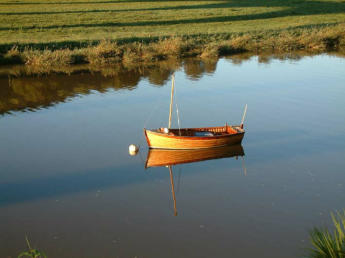
In water, lighter objects tend to read darker and darker objects can read a little lighter.
Use a color wheel to find realistic shifts. A light blue hull may reflect as a darker, more muted blue. Even in sunlight that lights every plank, the reflection will sit a notch darker. Build values gradually so you don’t overcommit too soon.
Do this...
- Use a color wheel to choose muted counterparts.
- Build mid‑values first, deepen darks slowly, reserve highlights for last.
Quick coloured‑pencil moves...
- Vertical, broken strokes hint at gentle ripples.
- Thin horizontal glazes calm the surface.
- Blend selectively—over‑burnishing kills the watery feel.
Quick takeaway: Muted, layered color beats bold, first‑pass color.
Step 5 — Outsmart the Perception Traps
Your brain loves shortcuts. It also loves to be wrong about reflections.
You might see the boat’s interior directly, yet its reflection shows more of the exterior - almost like a view from underneath.
That “doesn’t look right” feeling? It’s your expectation, not the water.
Do this...
Flip your reference (or your drawing) upside down. Errors pop.
Look for bounce light: sunlight can toss a golden glow onto a bird’s underside via the water. Paint what you see, not what you “know.”
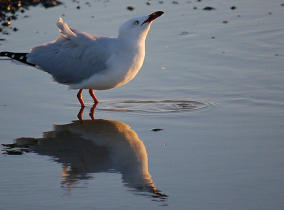
Step 6 — Observe, Then Adjust
Slow down, scan, correct.
Track the true shape, size, and color in the water—not the object’s. Make micro‑adjustments to edges and values after your first pass.
Micro‑checklist
- Is the reflection slightly softer and darker?
- Are small features simplified rather than copied?
- Do ripples gently break straight lines?
Real-World Proof - How the Method Predicts What You'll See
Example 1 — The Loire Region
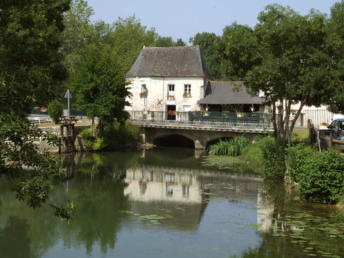
The right-hand building is partly hidden by a tree; only the left side shows in the water, partial visibility is normal.
The low mill shed sits back from the road bridge; only a hint of its rooftop appears in the reflection.
Distant trees disappear entirely from the water, far objects can drop out.
The mill cottage shows only its top floor in the reflection; the front door stays unseen.
Example 2 — Honfleur Harbour
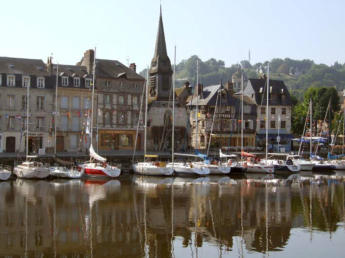
Waterfront buildings shrink and seem set back from the harbour wall in the water.
The distant hill disappears entirely. Boat masts look angled, bent by the reflection, not rigid copies.
Use the Flip Test (Your Fastest Reality Check)
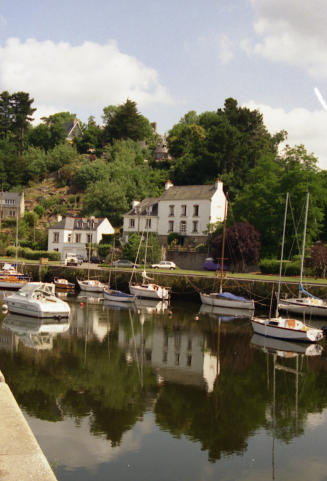 The old port at Pont Aven in Southern Brittany. Is this real or the reflection?
The old port at Pont Aven in Southern Brittany. Is this real or the reflection?Turn the scene—or your drawing—upside down.
Upside down, your brain stops naming objects and starts seeing shapes and values. The reflection can feel like a “beneath‑the‑surface” view, with boats hovering above—because the reflection shows different facets than your direct view.
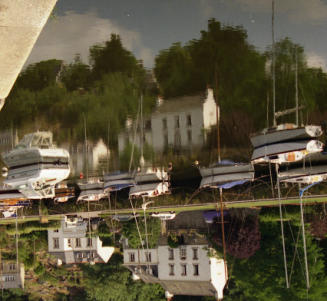
Put It All Together — A Short Checklist
- Viewpoint first. Where are you standing, and what does the water actually show from there?
- Block the reflection’s big shapes. Similar proportions, not a mirror copy.
- Downgrade clarity. Softer edges, fewer details, darker overall.
- Tune color with a wheel. Mute and deepen reflected hues.
- Beat bias. Flip the reference; verify interior/exterior cues.
- Finish gently. Add light ripples, glaze values, keep it soft.
Draw this way and you’ll capture the real differences between object and reflection - the tiny truths that make a waterscape feel alive.
Want to see these ideas in action around boats? We’ll explore the intricate interplay between a boat and its surrounding water on our dedicated page on drawing a boat.
Improve Your Pencil Art: Get Free Tips & Techniques
Sign up for our newsletter – just occasional emails packed with practical advice and inspiration for pencil artists like yourself




